All About Kamayan-Style Dining
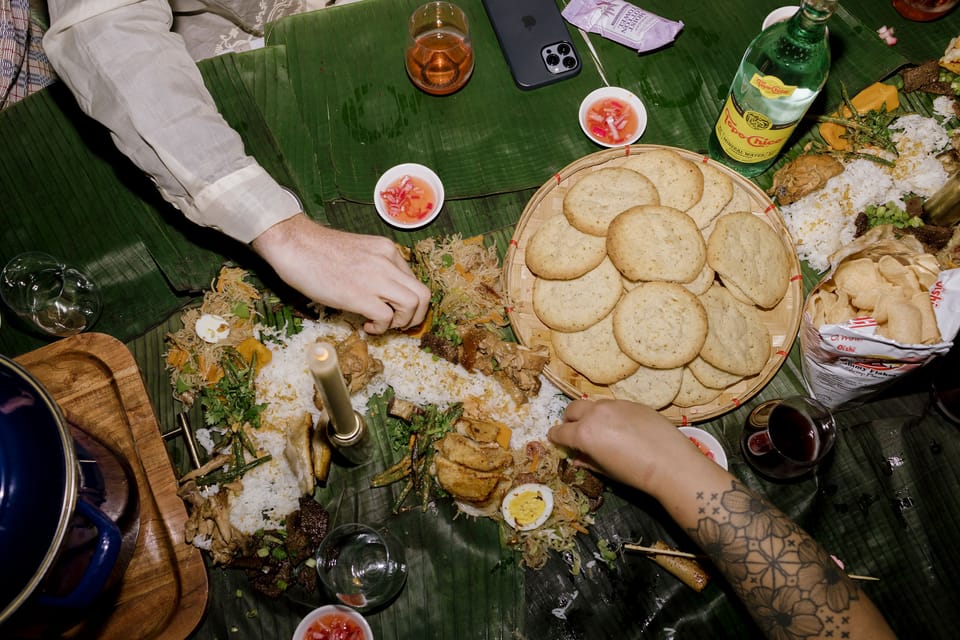
We consider ourselves lifelong students of kamayan, a Filipino feasting tradition where guests dine with their hands from a banana-leaf-lined table. It's a grand presentation with rice as the anchor, and multiple dishes are scattered along the length of the table for guests to sample. It is a celebratory meal with many components that are considered labor-intensive, like lumpia (eggrolls) and lechon (whole roasted pig!).
For Saveur, Jasmine Ting writes,
"Kamayan (from kamay, 'hand, in Filipino) refers to the pre-colonial tradition of eating without cutlery. Sixteenth-century Italian scholar and explorer Antonio Pigafetta, who documented Philippine history during the Magellan expedition, noted that natives used wooden spoons for serving and cooking—but not for eating."
In Filipinx, a cookbook by Angela Dimayuga and Ligaya Mishan, they add,
"These days, Filipino restaurants in the United States have started serving kamayan feasts inspired by the boodle fight, a military practice of feeding the troops at long tables cloaked in banana leaves and half buried under mounds of food."
A distinguishing trait of a boodle fight is standing, not sitting. Those in the military would gather around the table and eat quickly, almost like a dogfight with your hands to get your fill, or you'll be left hungry.
In an interview with FEAST Magazine, Charlene Young of The Fattened Calf in St. Louis explains a notable difference stateside,
“Kamayan in the U.S. has evolved as part of the Filipino diaspora experience. In the Philippines, it’s an everyday tradition, still practiced … with less focus on aesthetics and more focus on the act of sharing. A Kamayan in the U.S. focuses heavily on the feasting experience and has become a gathering place for Filipino Americans to re-experience the community they left behind or reconnect them back to their ancestral land.”
Read on to learn about kamayan, its benefits, where to try it, what to serve, and entertaining tips if you want to organize one yourself. We put together a collection on Etsy of items we think would be helpful, too.
Where to Try Kamayan
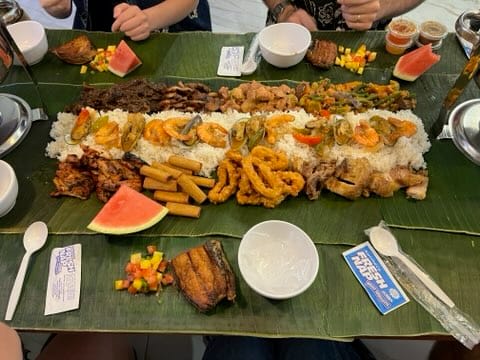
If you're nervous about making a kamayan meal for the first time, our advice is to try it at a restaurant!
Kabayan (Woodside, Queens NY) is our favorite spot because you can add bulalo and crispy pata to your meal. For a group of 12, it was around $75 per person. Note that they only serve soft drinks.

Gugu Room (New York City, NY) hosts Kamayan Fiesta Nights on Sundays, Tuesdays, and Wednesdays. It costs $50 to $65 per person, depending if you want to customize the items. Their Manila Mule with calamansi honey is one of our favorite cocktails. Ask about their off-menu porchetta!
Ihawan (Queens, NY) prepares platters in multiples of 2, 4, 6, and 8 guests, ranging from $55.00 to $160.00, respectively. The biggest platter has the most items, including crispy pata, tortang talong, pork BBQ, shrimp, calamari, pork tocino, lumpia Shanghai, and their soup of the day.
How to Set the Table

The number one benefit of Kamayan is fewer dishes to do at the end of the night. Since everyone is eating with their hands, you don't need plates or utensils. Because all of the food is placed on banana leaves, clean up is simply rolling them all up into a bundle and tossing them in the trash.
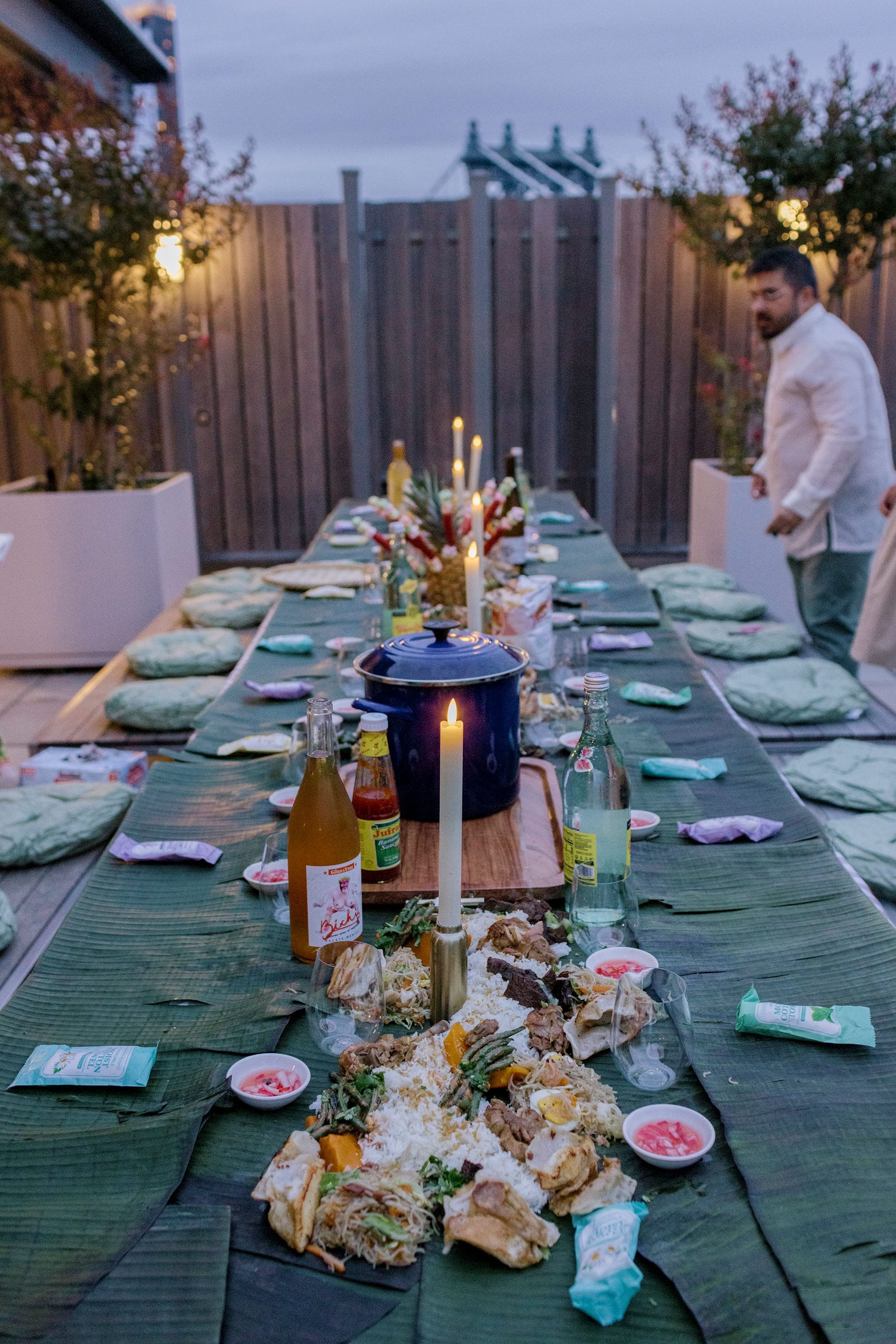
The first order of business in Kamayan is setting the table. Since you'll be eating from it, you need to prepare the banana leaves. Most of them in the United States are sold by the pound and frozen. They need to be defrosted and then wiped dry.
In the New York Times, Nicole Ponseca demonstrates an optional extra step to bring out the banana leaf's aroma and sheen,
The banana leaf was chalky and stiff from the freezer, in need of revival. Nicole Ponseca laid it across the stove and swept it gently over the flames. "To unlock the oils," she said.For Ponseca, who runs the Filipino restaurants Maharlika and Jeepney in the East Village, banana leaves are not an exotic accessory, but an everyday necessity. They serve as place mats, plates and to-go cartons, as a lining for pans to keep food from burning, and as pouches to seal in flavors. They impart flavors of their own, ghosts of grass and anise ("a scent you can taste," as she describes it. [...] On the stove, the banana leaf was starting to shine. Ponseca lifted it and traced the veins. "It's alive now," she said. "It was sleeping."
A word of warning about your dining table: if it has a heat-sensitive wood finish, consider purchasing a few large squares of wood to put on a tablecloth (to prevent scratches) and cover those pieces of wood with banana leaves. The heat from the rice can discolor specialty table glazes, so ask the table's owner if you need to take precautions.

We learned a hard lesson while catering a wedding at Callisto in upstate New York. Wedding tables need to be set up many hours ahead with flowers and decor, but this proved to be a mistake in the open air. Our banana leaf table linings burned and curled up in direct summer sunlight! We were able to salvage "islands" of banana leaves and some banana leaf "plates" for the evening. If you're planning an outdoor kamayan in hot weather, plan to use a tent to shade the leaves or keep a stack of compostable plates on hand just in case.
Speaking of decor, keep it minimal. The showstopper visual should be the food. Avoid using inedible items or flowers directly on the eating surface, as it could confuse a guest and choke them. Use vases, bud vases, and candle holders to elevate the decor so it does not touch the food.
Since guests will be eating with their hands, ensure there is a way for them to wash their hands. If there is no sink nearby, invest in a handwashing basin and towels or pre-moistened towelettes. We prefer cloth-based towelettes because the paper ones you get at BBQ restaurants aren't sturdy enough to get rice off your hands.
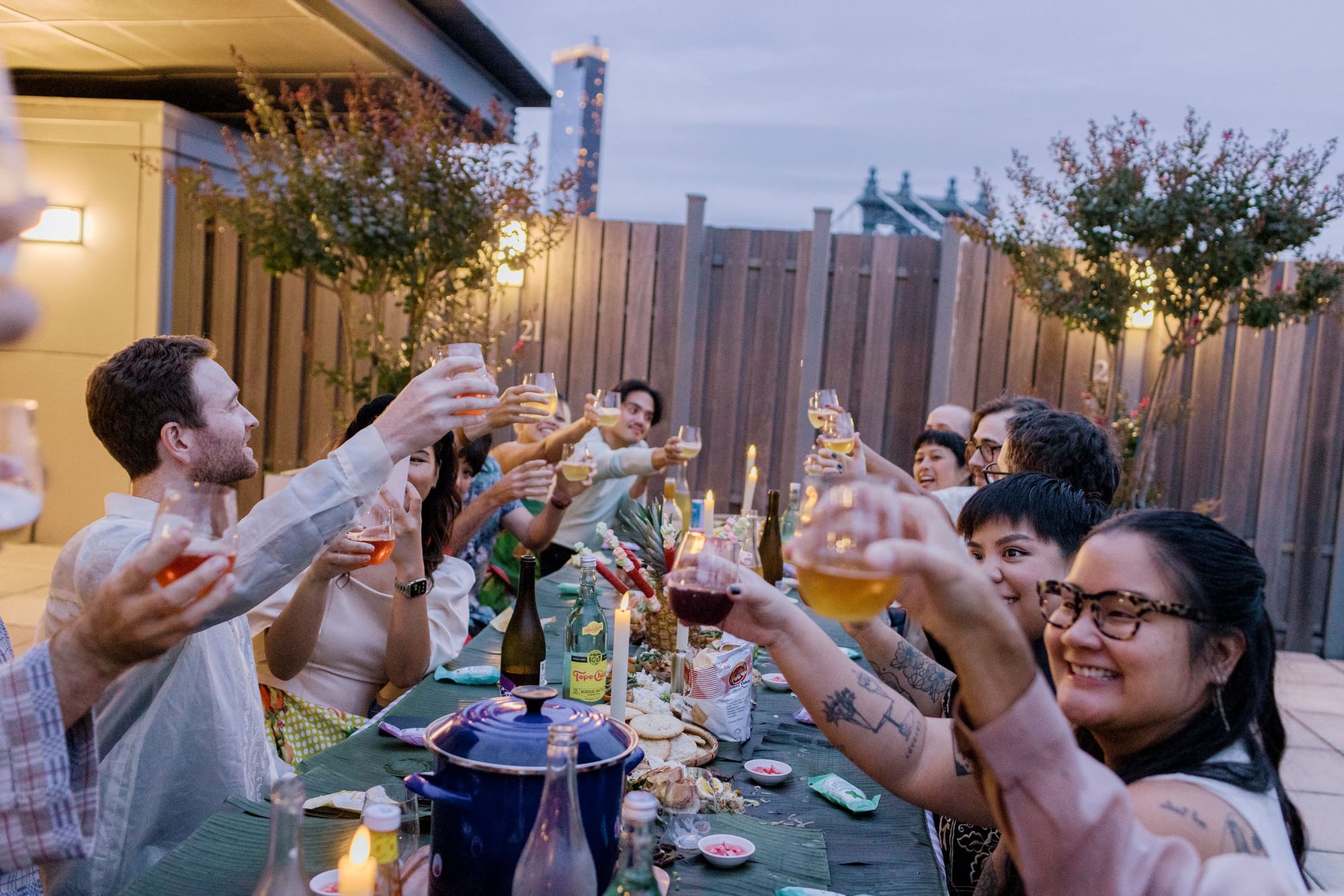
When dining outdoors, keep the glassware to a minimum to prevent breakage. Plus, if your hands have been touching food, picking up a glass makes it greasy. We prefer to use compostable stemless wine cups for this purpose.
Finally, take note of your guests' dietary restrictions. To prevent cross-contamination, seat those with specialty diets near each other and section off the meats. Always make sure everyone has enough to eat!
What to Serve for Kamayan
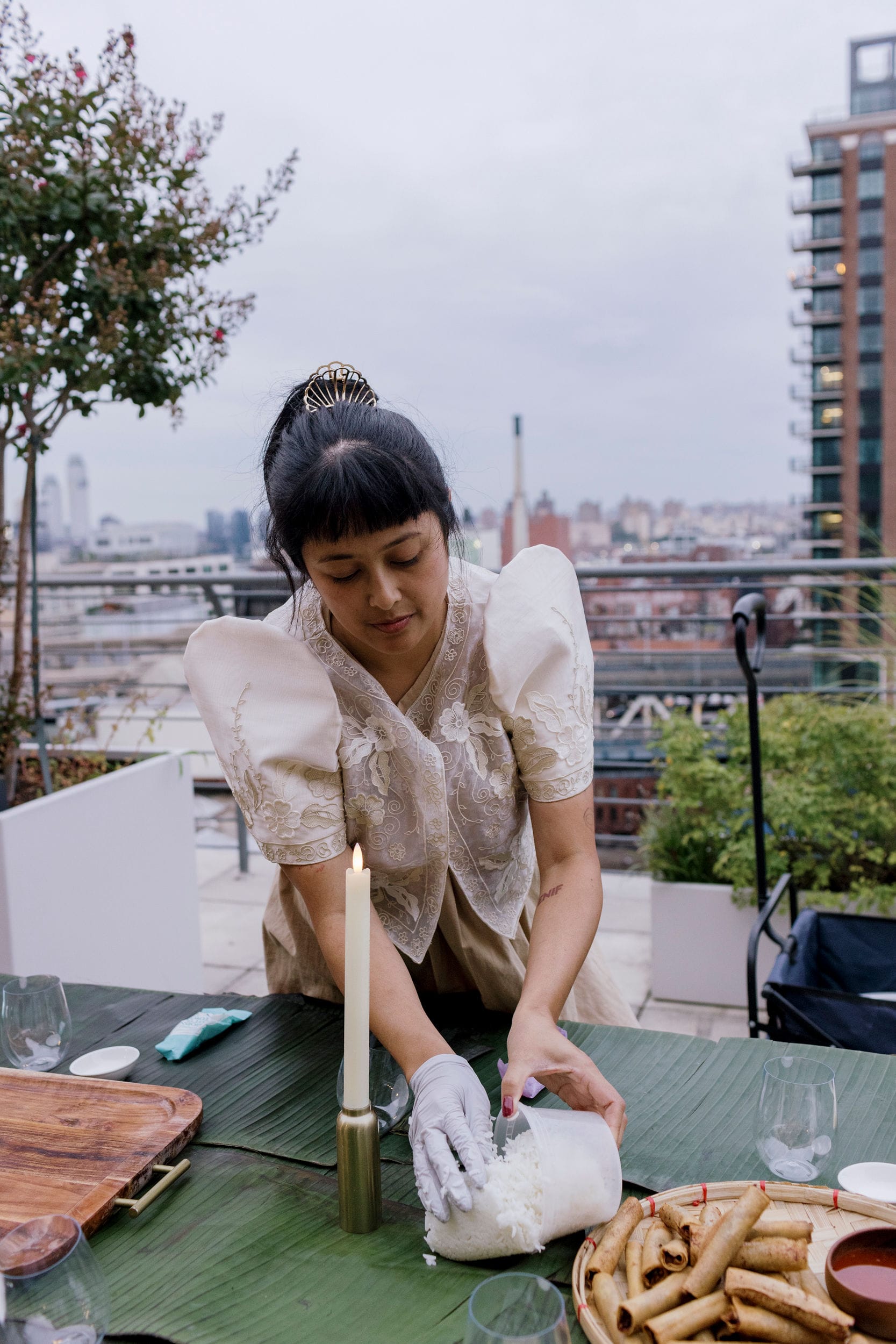
Rice is the only non-negotiable for Kamayan; it's the bedrock of the whole meal. You'll need an average of 1 cup per person (each cup of uncooked Jasmine rice makes 3 cups). We stick to Jasmine rice for its simplicity and grassy aromatics. You can try other kinds of rice, like plain brown, wild rice, or sticky rice. We don't recommend wet rice dishes like congee or risotto because they'd be tough to eat with your hands. Fried rice can be fun, but keep in mind that it's oily to the touch.
When curating the menu, start with a variety of proteins like chicken, pork, and fish. If you have the capacity to cook more, try to provide another protein like beef and a few vegetable options. See our list below for options!
Condiments can be placed in small ramekins at each setting, like atchara, bagoong alamang, suka (or sawsawan), banana ketchup, mang tomas, or freshly split calamansi fruits.
Soup can be part of Kamayan, but you'll need small sippable bowls at each seat. One of our favorites is the bulalo from Kabayan.

Kamayan doesn't have to be complicated; it can even be a smaller, intimate experience. Focusing the number of dishes to a select few can be cost-effective. One weekend, we catered a tabletop RPG weekend in Calicoon. We served a bed of jasmine rice with fried garlic, chicken inasal, squat longanisa, vegan pinakbet, and sides of atchara.

To lessen the burden of cooking, share the load and plan a potluck. For our Sunset Kamayan Dinner Party, we set the table, made the rice, and a batch of our thyme-scented lumpia Shanghai. We coordinated the rest of the dishes with guests so there were no overlaps. For those who were pressed for time, they ordered an ube cake from a bakery or dumplings from a restaurant.
List of Kamayan Dishes
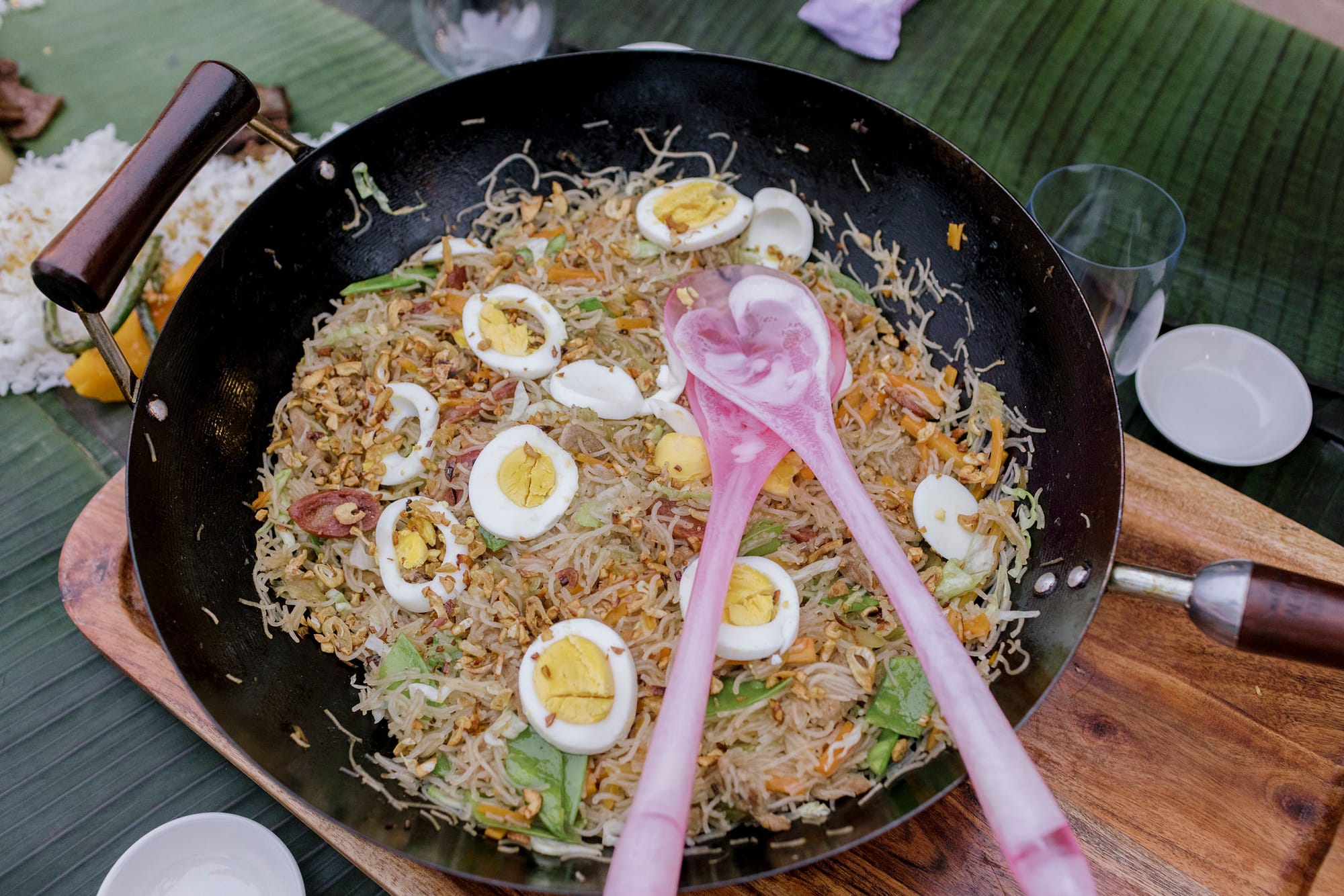
We've sorted our favorite Filipino dishes by protein and difficulty. One * is easy, while five ***** is more difficult. The difficulty also includes longer time commitments.
Fillers & Condiments
- Atchara*** - Pickled papaya, carrot, peppers, and shallot. Available jarred, too.
- Bagoong alamang* - A jarred brine shrimp paste, a little goes a long way.
- Banana ketchup* - Exactly as it sounds.
- Calamansi**- A unique Filipino fruit that tastes like a cross between tangerine and lime. Budget 2 to 3 fruits per person. It may be difficult to source fresh fruit. As an alternative, serve canned calamansi juice drinks to help cleanse the palate.
- Green mango with bagoong* - A palate cleanser between bites.
- Ensaladang mangga* - Green mango, tomato, cucumber, and onion salad.
- Jasmine rice* - Steamed aromatic rice.
- Mang tomas* - A liver-based sauce, excellent with fried pork.
- Pancit Bihon***- Stir-fried rice or starch noodles with vegetables and multiple proteins.
- Pancit Canton***- Stir-fried wheat noodles with vegetables and multiple proteins.
- Suka (or sawsawan)**- Seasoned vinegar, often contains Thai chilies, garlic, and sometimes dried fruit.
Beef
- Beef caldereta** - Stewed beef with vegetables, olives, and liver sauce.
- Beef tapa* - Marinated and air-dried beef tenderloin.
- Bulalo *** - Beef shank and bone marrow soup with cabbage.
- Corned beef**- Not the deli meat! Canned corned beef sauteed with onions and cubed potatoes.
- Kare kare**- Oxtail peanut stew.
Chicken
- Adobo chicken* - Soy sauce and vinegar braised chicken with garlic.
- Chicken inasal*** - Grilled marinated chicken.
- Fried chicken***- Yes, fried chicken! Make it yourself or get a bucket of ChickenJoy from Jolibee.
Pork
- Crispy Pata***** - Deep-fried pork knuckle.
- Lechon kawali****- Deep-fried pork belly pieces.
- Liempo****- Marinated and grilled pork belly pieces.
- Longanisa* - Readymade sweet sausages, available in most Filipino stores.
- Lumpia Shanghai **** - Ground pork eggrolls.
- Tocino** - Sweet sticky pork pieces.
Fish & Shellfish
- Adobo squid* - Soy sauce and vinegar braised squid with garlic. Sometimes uses the squid ink.
- Bangus** - Vinegar-marinated milk fish. Most are deep-fried, but can also be steamed.
- Grilled tilapia**- Simple grilled fish.
- Sinigang na isda**- Tamarind-soured soup with tomato, onion, and fish.
- Grilled Shrimp** - Shrimp marinated in garlic and lemon soda.
Vegetables
- Bok choy*- Either steamed or simply grilled.
- Lumpia Gulay*** - Vegetable eggrolls.
- Pinakbet** - Quickly steamed vegetables. Most recipes use bagoong alamang (shrimp paste), but substitute miso to make it vegan.
- Tortang Talong** - Eggplant omelette.
What are you waiting for? Plan a Kamayan feast and let us know in the comments if you have questions.

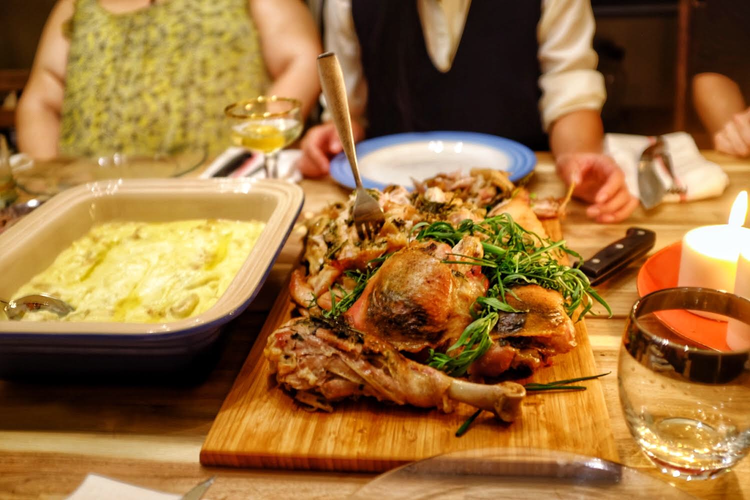
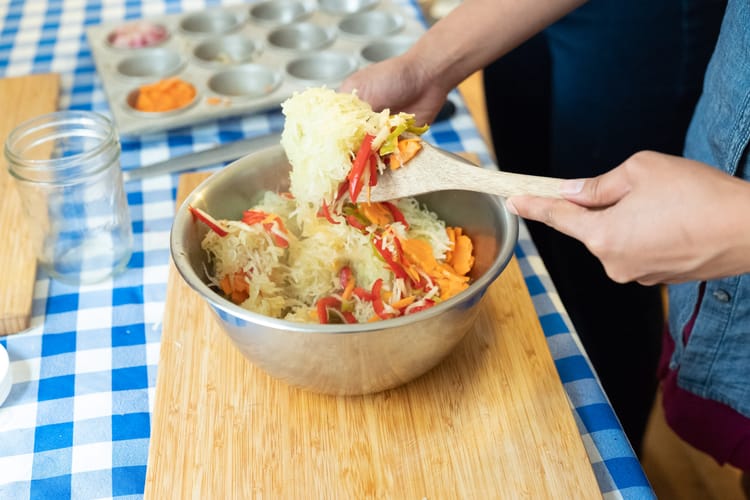
Comments ()